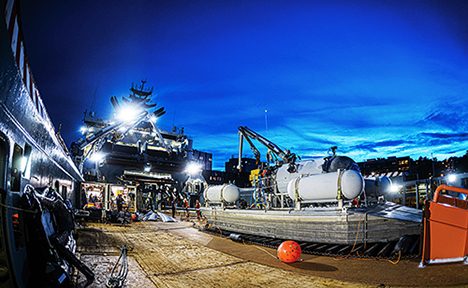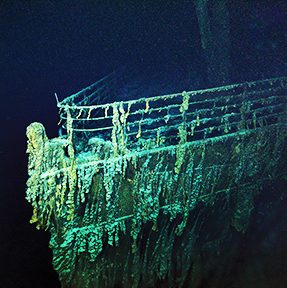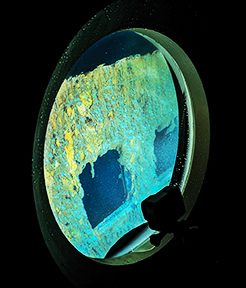OceanGate’s innovative submersible makes history.
STOCKTON RUSH AND HIS TEAM AT OCEANGATE made history on July 10, 2021, when they reached the Titanic — at a depth of approximately 12,500 feet — in Titan, the only submersible of its kind. The dive proved that this unique cylinder-shaped, carbon fiber and titanium five-person submersible can explore this wreck and was a momentous step toward OceanGate’s ultimate vision of expanding humanity’s access to the deep ocean.
A month before joining Rush and his handpicked mission specialists, Titanic experts, and the OceanGate expedition team on board the Horizon Arctic for the first mission to test Titan on the Titanic, I asked what made Titan different from anything ever built. “Essentially, the difference is the carbon fiber and titanium pressure vessel,” Rush explained. “People have successfully used carbon fiber for yachts and aircraft but hadn’t yet applied it to crewed submersibles. A lot has changed in the past 50 years. We now know a lot about composites and how to manufacture and test them to make sure they are OK.”
Carbon fiber would allow submersibles to be lighter, so Rush began to consider how to efficiently utilize the interior space to carry more people to great depths. He also recognized that the industry and its funding sources are committed to using and incrementally improving metal submersibles. To meet his ambitious goal of better access for more people, he would have to build his own.
On board the Horizon Arctic, I talked to Renata Rojas while she prepared for the first round of Titan’s test dives to the Titanic. “It’s a unique opportunity to live out my dream of being an oceanographer,” said Rojas, who has been a mission specialist on several shallower excursions. “I’m on the ship and working in the sub with people I’ve read about in books and followed on television, and they are passing down their experience to me. How can you put a price on a dream?”
This is not just any expedition, though — the Titanic strikes a deep emotional chord with millions of people across the planet. Many aspire to explore its secrets or merely visit the site, as we did each day for a week.
That broad interest led Rush to endeavor to take people on expeditions to the Titanic. “We are trying to get more people underwater,” he said. “I can do that from both a technological and a business approach. There is not enough money going into research, yet the technology exists to do some unique things with the right submersible.”

Photo by David Concannon

Photo courtesy of OceanGate
Rush understood that the Titanic is the rare underwater site that billions of people recognize and would draw both interest and funding to his efforts. Once OceanGate decided to take people to the Titanic, they had to assess how their existing technology was suited for a journey to the ocean floor. The parameters of such a task led them to decisions such as what type of titanium to use, how much of the structure could be carbon fiber, how large they could make the viewport, and whether to use acrylic or glass for it. Like many innovators, Rush tapped into public fascination to generate the funding necessary to create new technology.
Our expedition departs from St. John’s, Newfoundland, located at the very edge of the closest landmass to the Titanic site, which is more than 400 miles into the open ocean. As we head further out to sea, I hope for an iceberg sighting. Gone are the near-shore pods of humpback whales and the dolphins leaping and playing in the ship’s wake. Seabirds are rare, except for a few stragglers who find respite on the back deck after flying for days without land in sight. The deep ocean’s ever-changing cerulean blue, the turquoise and white engine froth, and the charcoal gray waves with whitecaps swirl together here in the North Atlantic, where the Horizon Arctic floats directly above the Titanic’s stern.
There is something profound about the expedition’s dance of technology and innovation. Constructed in 2016, the Horizon Arctic holds an environmentally friendly clean design class notation. The Titanic below us, completed in 1911, had feats of engineering that represented the best minds of its time. As I stand on the deck of a modern ship, ready to clear the cable lines on the communications bar as it lifts into position, the Titanic’s hull still holds the Marconi wireless telegraph responsible for saving so many lives.
Activity buzzes around Titan. The crew fills the air tanks on the platform, oils parts, and fits the carbon-fiber manifolds on the submersible after a tune-up. Pushing the envelope and paving the way for increased access to deep-sea exploration, the platform and the sub will soon make technological history.
The culture on board is respectful and conversational, with regular safety adjustments and consistent problem-solving. That culture spans from the ship’s captain to cadet interns and is present in Rush’s briefings and the eagerness of each team member to pitch in at every level. Each morning the talented kitchen crew greets us at dawn with fresh coffee, a hearty breakfast, and an abundance of cheer. There is no shortage of food or snacks to keep us well-fueled for the days and nights ahead.
We make a lot of progress on the first mission but the stars do not yet align for a Titanic dive. Despite that, we feel like we are moving forward.
Titan meets Titanic on the ocean floor during the second mission, making history and accomplishing an important milestone in the future of ocean exploration.
P.H. Nargeolet, a former French Navy commander who led five prior Titanic expeditions and has visited the Titanic more than 30 times, participated in each test dive since he arrived on the ship two weeks before us. He was on the first dive to reach the site and stayed until the last day, allowing him to survey the wreck multiple times. “This dive is one of the most memorable I have ever done,” he said. “Being able to participate in the deployment and operation of such a ground-breaking sub and launch system reminded me of the challenges that my team overcame and the determination they exhibited in the development of the Nautile more than 35 years ago.”
The OceanGate team completed several successful dives to survey the Titanic aboard Titan, the world’s only five-person submersible to reach a depth of 13,000 feet, over the six weeks after our first expedition. The team of renowned experts, researchers, and citizen scientists collected the highest-quality photographs and wreck footage to date, including parts of the wreck never photographed before. OceanGate’s Titanic footage is available at youtu.be/oDLzG1W0Cik.
By the end of 2021, the team had accomplished 10 successful dives to the Titanic: four at depth along the debris field and six surveys of the wreck. Titan’s large viewport allowed three people to simultaneously view and document the Titanic as the pilot and copilot attended to the controls.
The expedition’s mission is to document the wreck’s condition and assess the marine life while leaving the wreck untouched. Preliminary observations show that the wreck has deteriorated significantly. The bow section has sunk farther into the ground, and the anchor, once 60 feet from the bottom, is now merely 10 feet.
Next summer OceanGate will have several missions that stay true to its vision of increasing access to and fostering respect for the deep ocean. They will continue to host a selection of scientists, educators, and First Nations interns. A contest will also provide an opportunity for one or two winners to join an expedition.
Rojas, who has not yet taken a deep voyage in Titan, signed up for a summer 2022 Titanic expedition after seeing the results of our visit. “I want to see the ship,” he said. “I have a connection to it that I can’t explain. All I know is that I have to go down and be there. What do I expect to find? I don’t know. Maybe myself.”

Photo courtesy of OceanGate

Photo courtesy of OceanGate
Explore More
See more of OceanGate’s 2021 Titanic survey expedition in this video.